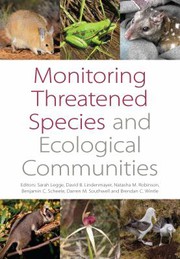Check nearby libraries
Buy this book

This edition doesn't have a description yet. Can you add one?
Check nearby libraries
Buy this book

Showing 2 featured editions. View all 2 editions?
| Edition | Availability |
|---|---|
| 1 |
aaaa
Libraries near you:
WorldCat
|
|
2
Monitoring Threatened Species And Ecological Communities
2018, Csiro Publishing,
in English
1486307728 9781486307722
|
zzzz
Libraries near you:
WorldCat
|
Book Details
Table of Contents
Chpt. 1: Introduction: making it count. Sarah Legge, David B. Lindenmayer, Natasha M. Robinson, Benjamin C. Scheele,Darren M. Southwell, Brendan A. Wintle, John C.Z. Woinarski and Elisa Bayraktarov. Section 1 Monitoring extent and adequacy. Chpt. 2: A framework for evaluating the adequacy of monitoring programs for threatened species. John C.Z. Woinarski. Chpt. 3: The extent and adequacy of monitoring for Australian threatened mammal species. John C.Z. Woinarski, Andrew A. Burbidge and Peter L. Harrison. Chpt. 4: The extent and adequacy of monitoring for Australian threatened bird species. Stephen T. Garnett and Hayley M. Geyle. Chpt. 5: The extent and adequacy of monitoring for Australian threatened frog species. Benjamin C. Scheele and Graeme R. Gillespie. Chpt. 6: The extent and adequacy of monitoring for Australian threatened reptile species. John C.Z. Woinarski. Chpt. 7: The extent and adequacy of monitoring for Australian threatened freshwater fish species. Mark Lintermans and Wayne Robinson. Chpt. 8: Monitoring threatened ecosystems and ecological communities. David A. Keith, Belinda T. Pellow and Matthew Appleby. Chpt. 9: Summary: monitoring extent and adequacy for threatened biodiversity. Sarah Legge, Benjamin C. Scheele, John C.Z. Woinarski, Stephen T. Garnett, David A. Keith, Mark Lintermans, Natasha M. Robinson and David B. Lindenmayer.
Section 2 The value of monitoring. Chpt. 10: The value of assessing species recovery: towards a national framework. Peter Latch. Chpt. 11: Shorebird monitoring in Australia: a successful long-term collaboration among citizen scientists, governments and researchers. Birgita D. Hansen, Robert S. Clemens, Eduardo Gallo-Cajiao, Micha V. Jackson, Richard T. Kingsford, Grainne S. Maguire, Golo Maurer, David A. Milton, Danny I. Rogers, Dan R. Weller, Michael A. Weston, Eric]. Woehler and Richard A. Fuller. Chpt. 12: A tale of threatened frogs: demonstrating the value of long-term monitoring. Graeme R. Gillespie, David Hunter, Greg Hollis; Benjamin C. Scheele and Matt West. Chpt. 13: Insights from multi-species mammal monitoring programs in the Upper Warren, Western Australia. Adrian Wayne. Chpt. 14: The multiple benefits of monitoring threatened species: Leadbeater's possum as a case study. David B. Lindenmayer. Chpt. 15: Summary: the value of monitoring threatened biodiversity. David B. Lindenmayer, Natasha M. Robinson, Benjamin C. Scheele and Sarah Legge.
Section 3 Monitoring frameworks. Chpt. 16: Why, what, how much, and is it worth it? Questions to answer before spending a penny on monitoring. Brendan A. Wintle. Chpt. 17: Saving our Species: a cost-effective, large-scale monitoring and evaluation program for threatened species. James Brazill-Boast. Chpt. 18: Designing a monitoring framework for Australian Wildlife Conservancy, a national conservation organisation. John Kanowski, Liana Joseph, Rod Kavanagh and Atticus Fleming. Chpt. 19: Parks Australia monitoring for threatened species. Kerrie Bennison, Jndy West and Kim Hauselberger.
Section 4 Monitoring program design. Chpt. 20: Optimising broad-scale monitoring for trend detection: review and re-design of a long-term program in northern Australia. Luke D. Einoder, Darren M. Southwell, Graeme R. Gillespie, Alaric Fisher, Jose J. Lahoz-Monfort and Brendan A. Wintle. Chpt. 21: Determining trends in irruptive desert species. Chris R. Dickman, Aaron C. Greenville and Glenda M. Wardle. Chpt. 22: The challenge of monitoring coastal marine mammals. Helene Marsh, Lyndon Brooks and Rie Hagihara. Chpt. 23: The technology revolution: improving species detection and monitoring using new tools and statistical methods. Jose J. Lahoz-Monfort and Reid Tingley. Chpt. 24: Summary: monitoring frameworks and monitoring program design for threatened biodiversity. Darren M. Southwell.
Section 5 Community participation. Chpt. 25: Threatened species monitoring on Aboriginal land: finding the common ground between Kuka, Jukurrpa, Ranger work and science. Rachel Paltridge and Anja Skroblin. Chpt. 26: Involving volunteers in threatened plant monitoring in South Australia: the best laid plans of plants and men. Doug Bickerton. Chpt. 27: Community involvement in monitoring threatened species: a WWF perspective. Jessica Koleck. Chpt. 28: What makes a successful citizen science program?. Kerryn Herman. Chpt. 29: Summary: community participation in monitoring for threatened biodiversity. Natasha M. Robinson, Sarah Legge and Benjamin C. Scheele.
Section 6 Monitoring and adaptive management. Chpt. 30: Recovery of the red-finned blue-eye: informing action in the absence of controls and replication. Jim Radford, Rob Wager and Adam Kerezsy. Chpt. 31: The national malleefowl monitoring effort: citizen scientists, databases and adaptive management. Joe Benshemesh, Darren M. Southwell, Jose J. Lahoz-Monfort, Cindy Hauser, Libby Rumpff, Michael Bode, Tim Burnard, John Wright and Br,endan A. Wintle. Chpt. 32: Difficulties in fitting an adaptive management approach to threatened species monitoring. David B. Lindenmayer. Chpt. 33: Summary: monitoring and adaptive management of threatened biodiversity. Benjamin C. Scheele and David B. Lindenmayer. Section 7 Bringing it all together. Chpt. 34: Organisational perspectives on threatened species monitoring. Chpt. 35: Essential principles to guide monitoring of threatened biodiversity.
Edition Notes
Includes bibliographical references and index.
Classifications
The Physical Object
ID Numbers
Community Reviews (0)
Feedback?| December 18, 2022 | Edited by MARC Bot | import existing book |
| October 11, 2020 | Edited by ImportBot | import existing book |
| May 24, 2019 | Created by MARC Bot | import new book |









